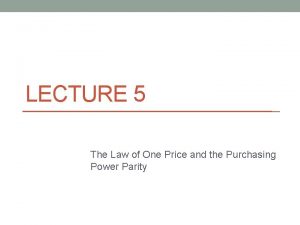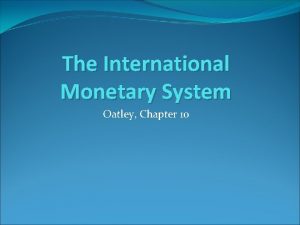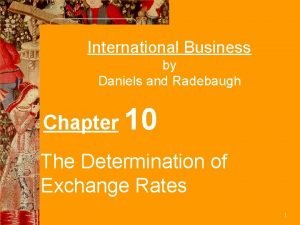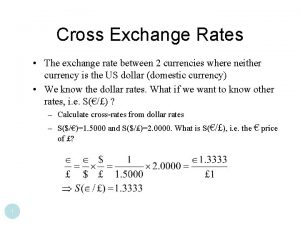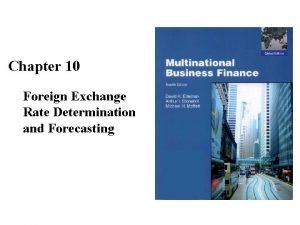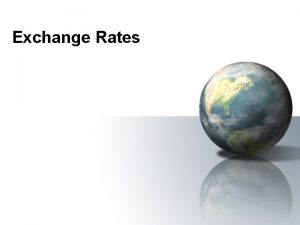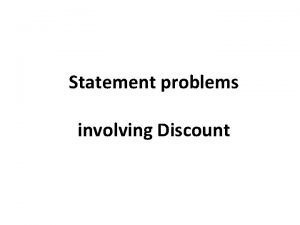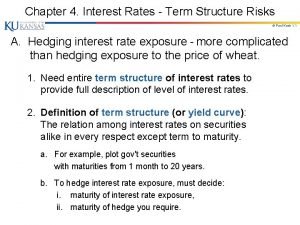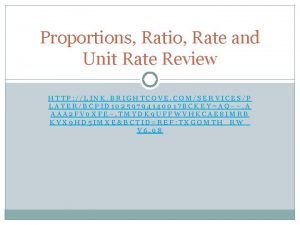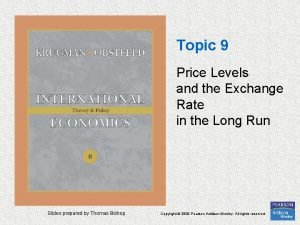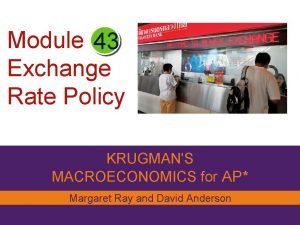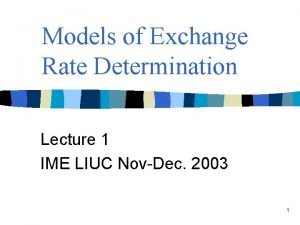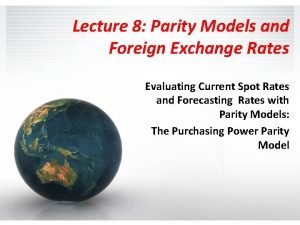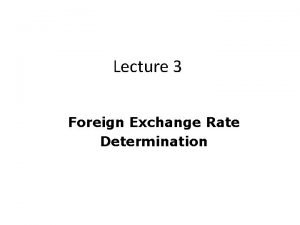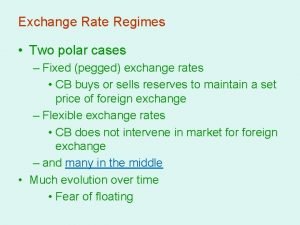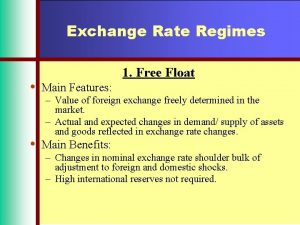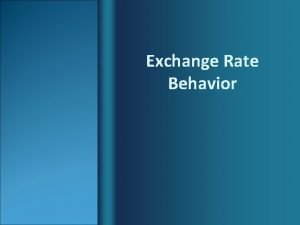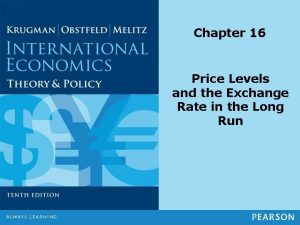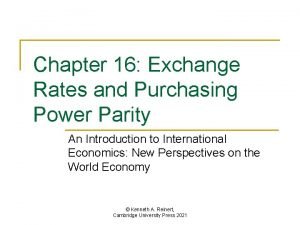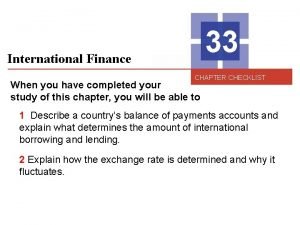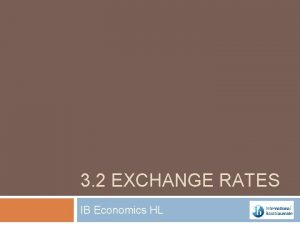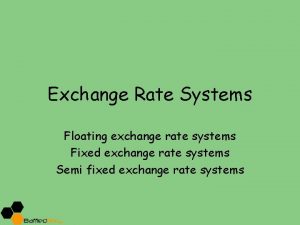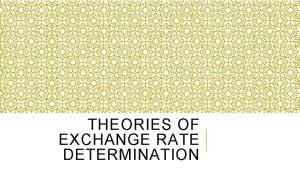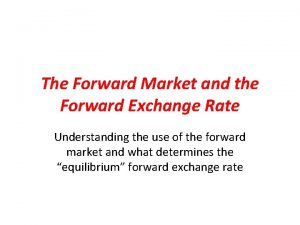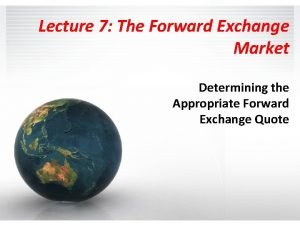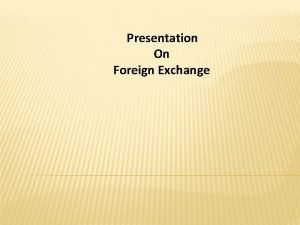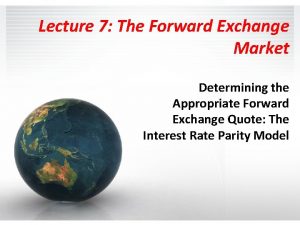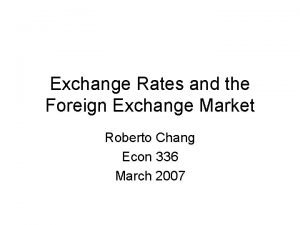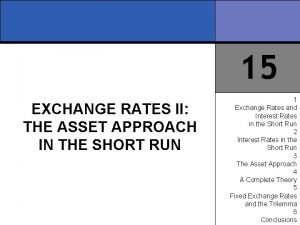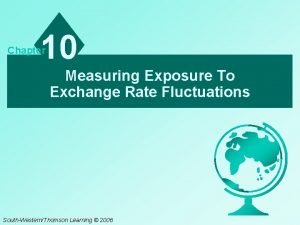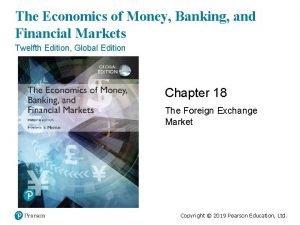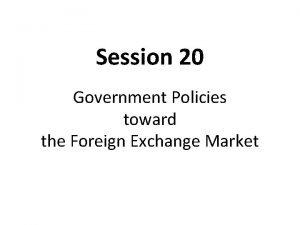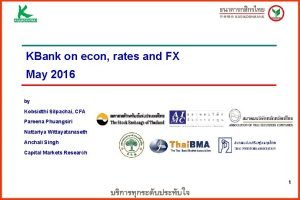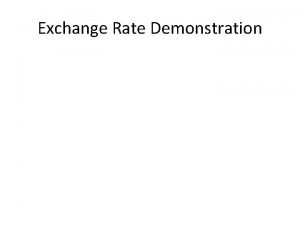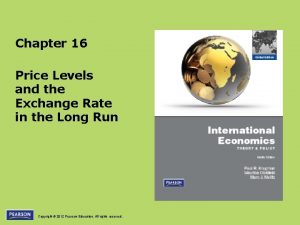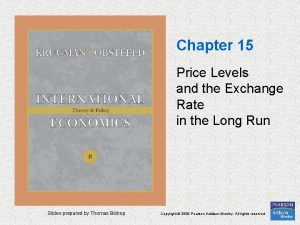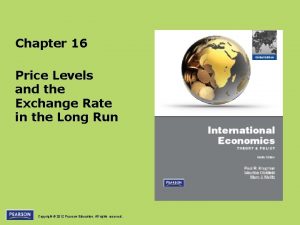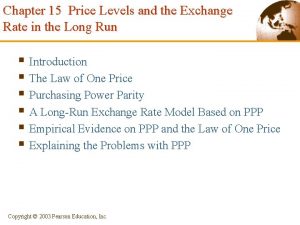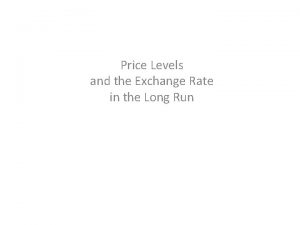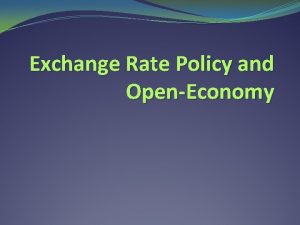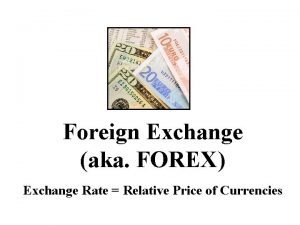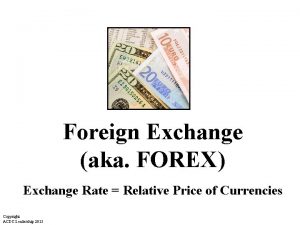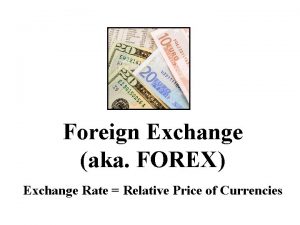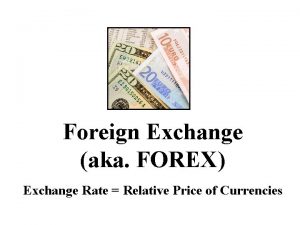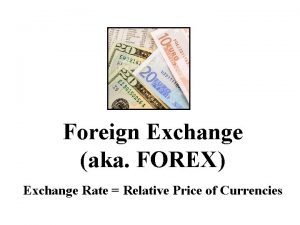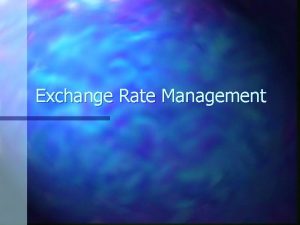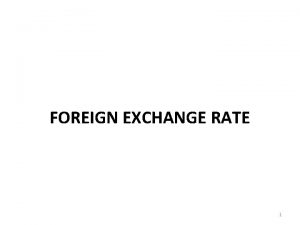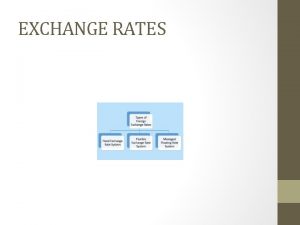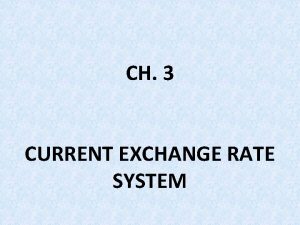Chapter 15 Price Levels and the Exchange Rate



















































- Slides: 51

Chapter 15 Price Levels and the Exchange Rate in the Long Run § Introduction § The Law of One Price § Purchasing Power Parity § A Long-Run Exchange Rate Model Based on PPP § Empirical Evidence on PPP and the Law of One Price § Explaining the Problems with PPP Copyright © 2003 Pearson Education, Inc.

Chapter Organization § Beyond Purchasing Power Parity: A General Model § § of Long-Run Exchange Rates International Interest Rate Differences and the Real Exchange Rate Real Interest Parity Summary Appendix: The Fisher Effect, the Interest Rate, and the Exchange Rate Under the Flexible-Price Monetary Approach Copyright © 2003 Pearson Education, Inc.

Introduction § The model of long-run exchange rate behavior § § provides the framework that actors in asset markets use to forecast future exchange rates. Predictions about long-run movements in exchange rates are important even in the short run. In the long run, national price levels play a key role in determining both interest rates and the relative prices at which countries’ products are traded. • The theory of purchasing power parity (PPP) explains movements in the exchange rate between two countries’ currencies by changes in the countries’ price levels. Copyright © 2003 Pearson Education, Inc.

The Law of One Price § Law of one price • Identical goods sold in different countries must sell for the same price when their prices are expressed in terms of the same currency. – This law applies only in competitive markets free of transport costs and official barriers to trade. – Example: If the dollar/pound exchange rate is $1. 50 per pound, a sweater that sells for $45 in New York must sell for £ 30 in London. Copyright © 2003 Pearson Education, Inc.

The Law of One Price – It implies that the dollar price of good i is the same wherever it is sold: Pi. US = (E$/€) x (Pi. E) where: Pi. US is the dollar price of good i when sold in the U. S. Pi. E is the corresponding euro price in Europe E$/€ is the dollar/euro exchange rate Copyright © 2003 Pearson Education, Inc.

Purchasing Power Parity § Theory of Purchasing Power Parity (PPP) • The exchange rate between two counties’ currencies • • equals the ratio of the counties’ price levels. It compares average prices across countries. It predicts a dollar/euro exchange rate of: E$/€ = PUS/PE (15 -1) where: PUS is the dollar price of a reference commodity basket sold in the United States PE is the euro price of the same basket in Europe Copyright © 2003 Pearson Education, Inc.

Purchasing Power Parity § By rearranging Equation (15 -1), one can obtain: PUS = (E$/€) x (PE) § PPP asserts that all countries’ price levels are equal when measured in terms of the same currency. Copyright © 2003 Pearson Education, Inc.

Purchasing Power Parity § The Relationship Between PPP and the Law of One Price • The law of one price applies to individual • • commodities, while PPP applies to the general price level. If the law of one price holds true for every commodity, PPP must hold automatically for the same reference baskets across countries. Proponents of the PPP theory argue that its validity does not require the law of one price to hold exactly. Copyright © 2003 Pearson Education, Inc.

Purchasing Power Parity § Absolute PPP and Relative PPP • Absolute PPP – It states that exchange rates equal relative price levels. • Relative PPP – It states that the percentage change in the exchange rate between two currencies over any period equals the difference between the percentage changes in national price levels, namely: – E$/€ /E$/€, t – 1 = US / E, where: t = inflation index – So that Er = E t – 1 * US / E – If less 1 in both 2 sides Copyright © 2003 Pearson Education, Inc.

– (E$/€ , t - E$/€, t – 1)/E$/€, t – 1 = ( US, t - E, t )/ E, t – If E, t is smaller ,Relative PPP between the United States and Europe would be: (E$/€ , t - E$/€, t – 1)/E$/€, t – 1 = US, t - E, t 2). . 中国的名义和实际. ppt Copyright © 2003 Pearson Education, Inc. (15 -



A Long-Run Exchange Rate Model Based on PPP § Monetary approach to the exchange rate • A theory of how exchange rates and monetary factors interact in the long run. § The Fundamental Equation of the Monetary Approach • Price levels can be expressed in terms of domestic money demand supplies: – In the United States: PUS = Ms. US/ L (R$, YUS) – In Europe: PE = Ms. E/L (R€, YE) (15 -3) (15 -4) – So that: E = PUS / PE = Ms. US* L (R€, YE) / Ms. E *L (R$, YUS) Copyright © 2003 Pearson Education, Inc.

A Long-Run Exchange Rate Model Based on PPP • The monetary approach makes a number of specific predictions about the long-run effects on the exchange rate of changes in: – Money supplies – An increase in the U. S. (European) money supply causes a proportional long-run depreciation (appreciation) of the dollar against the euro,if Y is given. – Interest rates – A rise in the interest rate on dollar (euro) denominated assets causes a depreciation (appreciation) of the dollar against the euro. – Output levels – A rise in U. S. (European) output causes an appreciation (depreciation) of the dollar against the euro, if M is given. Copyright © 2003 Pearson Education, Inc.

A Long-Run Exchange Rate Model Based on PPP § Ongoing Inflation, Interest Parity, and PPP • Money supply growth at a constant rate eventually results in ongoing inflation (i. e. , continuing rise in the price level) at the same rate. – Changes in this long-run inflation rate do not affect the full-employment output level or the long-run relative prices of goods and services. • The interest rate is not independent of the money supply growth rate in the long run. Copyright © 2003 Pearson Education, Inc.

A Long-Run Exchange Rate Model Based on PPP • The international interest rate difference is the difference between expected national inflation rates: R$ - R€ = e. US - e Copyright © 2003 Pearson Education, Inc. (15 -5)

A Long-Run Exchange Rate Model Based on PPP § The Fisher Effect • A rise (fall) in a country’s expected inflation rate will eventually cause an equal rise (fall) in the interest rate that deposits of its currency offer. – Figure 15 -1 illustrates an example, where at time t 0 the Federal Reserve unexpectedly increases the growth rate of the U. S. money supply to a higher level. Copyright © 2003 Pearson Education, Inc.

A Long-Run Exchange Rate Model Based on PPP Figure 15 -1: Long-Run Time Paths of U. S. Economic Variables after a Permanent Increase in the Growth Rate of the U. S. Money Supply (a) U. S. money supply, MUS (b) Dollar interest rate, R$ R$2 = R$1 + Slope = + MUS, t 0 R$ 1 Slope = t 0 (c) U. S. price level, PUS Time t 0 Time (d) Dollar/euro exchange rate, E$/€ Slope = + Slope = t 0 Copyright © 2003 Pearson Education, Inc. Time t 0 18 Time

A Long-Run Exchange Rate Model Based on PPP • In this example, the dollar interest rate rises because • • people expect more rapid future money supply growth and dollar depreciation. The interest rate increase is associated with higher expected inflation and an immediate currency depreciation. Figure 15 -2 confirms the main long-run prediction of the Fisher effect. Copyright © 2003 Pearson Education, Inc.

A Long-Run Exchange Rate Model Based on PPP Figure 15 -2: Inflation and Interest Rates in Switzerland, the United States, and Italy, 1970 -2000 20 Copyright © 2003 Pearson Education, Inc.

A Long-Run Exchange Rate Model Based on PPP Figure 15 -2: Continued 21 Copyright © 2003 Pearson Education, Inc.

A Long-Run Exchange Rate Model Based on PPP Figure 15 -2: Continued 22 Copyright © 2003 Pearson Education, Inc.

Empirical Evidence on PPP and the Law of One Price § The empirical support for PPP and the law of one price is weak in recent data. • The prices of identical commodity baskets, when • converted to a single currency, differ substantially across countries. 克鲁格曼网上课件Table 5_7. pdf Relative PPP is sometimes a reasonable approximation to the data, but it performs poorly. Copyright © 2003 Pearson Education, Inc.

Empirical Evidence on PPP and the Law of One Price Figure 15 -3: The Dollar/DM Exchange Rate and Relative U. S. /German Price Levels, 1964 -2000 Copyright © 2003 Pearson Education, Inc.

Copyright © 2003 Pearson Education, Inc.

Explaining the Problems with PPP § The failure of the empirical evidence to support the PPP and the law of one price is related to: • • Trade barriers and nontradables Departures from free competition International differences in price level measurement The level of Financial stability Copyright © 2003 Pearson Education, Inc.

Explaining the Problems with PPP § Trade Barriers and Nontradables • Transport costs and governmental trade restrictions make trade expensive and in some cases create nontradable goods. – The greater the transport costs, the greater the range over which the exchange rate can move. Copyright © 2003 Pearson Education, Inc.

Explaining the Problems with PPP § Departures from Free Competition • When trade barriers and imperfectly competitive • market structures occur together, linkages between national price levels are weakened further. Pricing to market – When a firm sells the same product for different prices in different markets. – It reflects different demand conditions in different countries. – Example: Countries where demand is more price-inelastic will tend to be charged higher markups over a monopolistic seller’s production cost. Copyright © 2003 Pearson Education, Inc.

Explaining the Problems with PPP § International Differences in Price Level Measurement • Government measures of the price level differ from country to country because people living in different counties spend their income in different ways. § PPP in the Short Run and in the Long Run • Departures from PPP may be even greater in the shortrun than in the long run. – Example: An abrupt depreciation of the dollar against foreign currencies causes the price of farm equipment in the U. S. to differ from that of foreign’s until markets adjust to the exchange rate change. Copyright © 2003 Pearson Education, Inc.

Explaining the Problems with PPP Figure 15 -4: Price Levels and Real Incomes, 1992 Copyright © 2003 Pearson Education, Inc.

Beyond Purchasing Power Parity: A General Model of Long-Run Exchange Rates § The Real Exchange Rate • It is a broad summary measure of the prices of one • • country’s goods and services relative to the other's. It is defined in terms of nominal exchange rates and price levels. The real dollar/euro exchange rate is the dollar price of the European basket relative to that of the American: q$/€ = (E$/€ x PE)/PUS (15 -6) – Example: If the European reference commodity basket costs € 100, the U. S. basket costs $120, and the nominal exchange rate is $1. 20 per euro, then the real dollar/euro exchange rate is 1 U. S. basket per European basket. Copyright © 2003 Pearson Education, Inc.

Beyond Purchasing Power Parity: A General Model of Long-Run Exchange Rates • Real depreciation of the dollar against the euro – A rise in the real dollar/euro exchange rate – That is, a fall in the purchasing power of a dollar within Europe’s borders relative to its purchasing power within the United States – Or alternatively, a fall in the purchasing power of America’s products in general over Europe’s. • A real appreciation of the dollar against the euro is the opposite of a real depreciation. Copyright © 2003 Pearson Education, Inc.

Beyond Purchasing Power Parity: A General Model of Long-Run Exchange Rates § Demand, Supply, and the Long-Run Real Exchange Rate • In a world where PPP does not hold, the long-run values of real exchange rates depend on demand supply conditions. Copyright © 2003 Pearson Education, Inc.

Beyond Purchasing Power Parity: A General Model of Long-Run Exchange Rates • There are two specific causes that explain why the long -run values of real exchange rates can change: – A change in world relative demand for American products – An increase (fall) in world relative demand for U. S. output causes a long-run real appreciation (depreciation) of the dollar against the euro. – A change in relative output supply – A relative expansion of U. S (European) output causes a longrun real depreciation (appreciation) of the dollar against the euro. Copyright © 2003 Pearson Education, Inc.

Beyond Purchasing Power Parity: A General Model of Long-Run Exchange Rates § Nominal and Real Exchange Rates in Long-Run Equilibrium • Changes in national money supplies and demands give • rise to the proportional long-run movements in nominal exchange rates and international price level ratios predicted by the relative PPP theory. From Equation (15 -6), one can obtain the nominal dollar/euro exchange rate, which is the real dollar/euro exchange rate times the U. S. -Europe price level ratio: E $/€ = q$/€ x (PUS/PE) (15 -7) Copyright © 2003 Pearson Education, Inc.

Beyond Purchasing Power Parity: A General Model of Long-Run Exchange Rates • Equation (15 -7) implies that for a given real dollar/euro exchange rate, changes in money demand or supply in Europe or the U. S. affect the long-run nominal dollar/euro exchange rate as in the monetary approach. – Changes in the long-run real exchange rate, however, also affect the long-run nominal exchange rate. Copyright © 2003 Pearson Education, Inc.

Beyond Purchasing Power Parity: A General Model of Long-Run Exchange Rates § The most important determinants of long-run swings in nominal exchange rates (assuming that all variables start out at their long-run levels): • • A shift in relative money supply levels A shift in relative money supply growth rates A change in relative output demand A change in relative output supply Copyright © 2003 Pearson Education, Inc.

Beyond Purchasing Power Parity: A General Model of Long-Run Exchange Rates § When all disturbances are monetary in nature, exchange rates obey relative PPP in the long run. • In the long run, a monetary disturbance affects only the general purchasing power of a currency. – This change in purchasing power changes equally the currency’s value in terms of domestic and foreign goods. • When disturbances occur in output markets, the exchange rate is unlikely to obey relative PPP, even in the long run. Copyright © 2003 Pearson Education, Inc.

Beyond Purchasing Power Parity: A General Model of Long-Run Exchange Rates Table 15 -1: Effects of Money Market and Output Market Changes on the Long-Run Nominal Dollar/Euro Exchange Rate, E$/€ 39 Copyright © 2003 Pearson Education, Inc.

Beyond Purchasing Power Parity: A General Model of Long-Run Exchange Rates Figure 15 -5: The Real Dollar/Yen Exchange Rate, 1950 -2000 40 Copyright © 2003 Pearson Education, Inc.


Beyond Purchasing Power Parity: A General Model of Long-Run Exchange Rates Figure 15 -6: Sectoral Productivity Growth Differences and the Change in the Relative Price of Nontraded Goods, 1970 -1985 42 Copyright © 2003 Pearson Education, Inc.

International Interest Rate Differences and the Real Exchange Rate § In general, interest rate differences between countries depend not only on differences in expected inflation, but also on expected changes in the real exchange rate. § Relationship between the expected change in the real exchange rate, the expected change in the nominal rate, and expected inflation: (qe$/€ - q$/€)/q$/€ = [(Ee$/€ - E$/€)/E$/€] – ( e. US - e. E) (15 -8) Copyright © 2003 Pearson Education, Inc.

International Interest Rate Differences and the Real Exchange Rate § Combining Equation (15 -8) with the interest parity condition, the international interest gap is equal to: R$ - R€ = [(qe$/€ - q$/€)/q$/€] + ( e. US - e. E) (15 -9) • Thus, the dollar-euro interest difference is the sum of two components: – The expected rate of real dollar depreciation against the euro – The expected inflation difference between the U. S. and Europe • When the market expects relative PPP to prevail, the dollar-euro interest difference is just the expected inflation difference between U. S. and Europe. Copyright © 2003 Pearson Education, Inc.

Real Interest Parity § Economics makes an important distinction between two types of interest rates: • Nominal interest rates – Measured in monetary terms • Real interest rates – Measured in real terms (in terms of a country’s output) – Referred to as expected real interest rates Copyright © 2003 Pearson Education, Inc.

Real Interest Parity § The expected real interest rate (re) is the nominal § § interest rate (r) less the expected inflation rate ( e). Thus, the difference in expected real interest rates between U. S. and Europe is equal to: re. US – re. E = (R$ - e. US) - (R € - e. E) By combining this equation with Equation (15 -9), one can obtain the desired real interest parity condition: re. US – re. E = (qe$/€ - q$/€)/q$/€ (15 -10) Copyright © 2003 Pearson Education, Inc.

Real Interest Parity § The real interest parity condition explains differences § in expected real interest rates between two countries by expected movements in the real exchange rates. Expected real interest rates in different countries need not be equal, even in the long run, if continuing change in output markets is expected. Copyright © 2003 Pearson Education, Inc.

Summary § Absolute PPP states that the purchasing power of any § § currency is the same in any country and implies relative PPP. Relative PPP predicts that percentage changes in exchange rates equal differences in national inflation rates. The law of one price is a building block of the PPP theory. • It states that under free competition and in the absence of trade impediments, a good must sell for a single price regardless of where in the world it is sold. Copyright © 2003 Pearson Education, Inc.

Summary § The monetary approach to the exchange rate uses PPP to explain long-term exchange rate behavior exclusively in terms of money supply and demand. • The Fisher effect predicts that long-run international interest differentials result from different national rates of ongoing inflation. § The empirical support for PPP and the law of one price is weak in recent data. • The failure of these propositions in the real world is related to trade barriers, departure from free competition and international differences in price level measurement. Copyright © 2003 Pearson Education, Inc.

Summary § Deviations from relative PPP can be viewed as § § changes in a country’s real exchange rate. A stepwise increase in a country’s money stock leads to a proportional increase in its price level and a proportional fall in its currency’s foreign exchange value. The (real) interest parity condition equates international differences in nominal (real) interest rates to the expected percentage change in the nominal (real) exchange rate. Copyright © 2003 Pearson Education, Inc.

Appendix: The Fisher Effect, the Interest Rate, and the Exchange Rate Under the Flexible-Price Monetary Approach Figure 15 A-1: How a Rise in U. S. Monetary Growth Affects When Goods Prices are Flexible Dollar/euro exchange rate, E$/€ 45° line E 2$/€ 2' 1' E 1$/€ Dollar/euro exchange rate, E$/€ PPP relation E 2$/€ E 1$/€ M 1 US P 2 US M 1 US P 1 US R$ 1 Initial expected return on euro deposits R$2 = R$1 + 2 Rates of return (in dollar terms) Money demand, L(R$, YUS) 1 U. S. real money holdings Copyright © 2003 Pearson Education, Inc. Expected return on euro deposits after rise in expected dollar depreciation 51
 Real exchange rate formula
Real exchange rate formula Ito ay kilala bilang maximum price policy
Ito ay kilala bilang maximum price policy Law of one price and purchasing power parity
Law of one price and purchasing power parity Has the exchange rate changed chapter 10
Has the exchange rate changed chapter 10 Has the exchange rate changed chapter 10
Has the exchange rate changed chapter 10 Price discovery and price determination
Price discovery and price determination Cross exchange rate formula
Cross exchange rate formula Exchange rate determination and forecasting
Exchange rate determination and forecasting Nominal exchange rate
Nominal exchange rate Level 3 question example
Level 3 question example Pearl exchange activity
Pearl exchange activity Gas exchange key events in gas exchange
Gas exchange key events in gas exchange Marked price-selling price=
Marked price-selling price= Difference between hire purchase system and credit system
Difference between hire purchase system and credit system Reactive procurement
Reactive procurement What is real interest rate and nominal interest rate
What is real interest rate and nominal interest rate What is growth analysis
What is growth analysis Bootstrapping spot rates
Bootstrapping spot rates Spot rate and forward rate
Spot rate and forward rate Difference between rate and unit rate
Difference between rate and unit rate Purchasing power parity formula
Purchasing power parity formula Border price adalah
Border price adalah Use the exchange market intervention figure 43-1
Use the exchange market intervention figure 43-1 Ime exchange rate
Ime exchange rate Mathematical literacy grade 12 exchange rate
Mathematical literacy grade 12 exchange rate Purchasing power parity meaning
Purchasing power parity meaning Ppp theory of exchange rate
Ppp theory of exchange rate Exchange rate trilemma
Exchange rate trilemma Crawling peg
Crawling peg Dirty float exchange rate
Dirty float exchange rate Foreign exchange means
Foreign exchange means Exchange rate equation
Exchange rate equation Nn smart move
Nn smart move Exchange rate depreciation example
Exchange rate depreciation example Overvalued currency
Overvalued currency Semi fixed exchange rate
Semi fixed exchange rate Types of exchange rate
Types of exchange rate Theories of interest rate determination
Theories of interest rate determination Forward exchange rate formula
Forward exchange rate formula Forward exchange rate formula
Forward exchange rate formula Foreign exchange market presentation
Foreign exchange market presentation Forward exchange rate formula
Forward exchange rate formula Eugene fama interview
Eugene fama interview Flexible exchange rate system definition
Flexible exchange rate system definition Ese exchange
Ese exchange Lessard lorange model
Lessard lorange model Exchange rate
Exchange rate Asset approach
Asset approach Measuring exposure to exchange rate fluctuations
Measuring exposure to exchange rate fluctuations Foreign exchange market graph
Foreign exchange market graph Clean float exchange rate
Clean float exchange rate Kbank exchange rate
Kbank exchange rate


